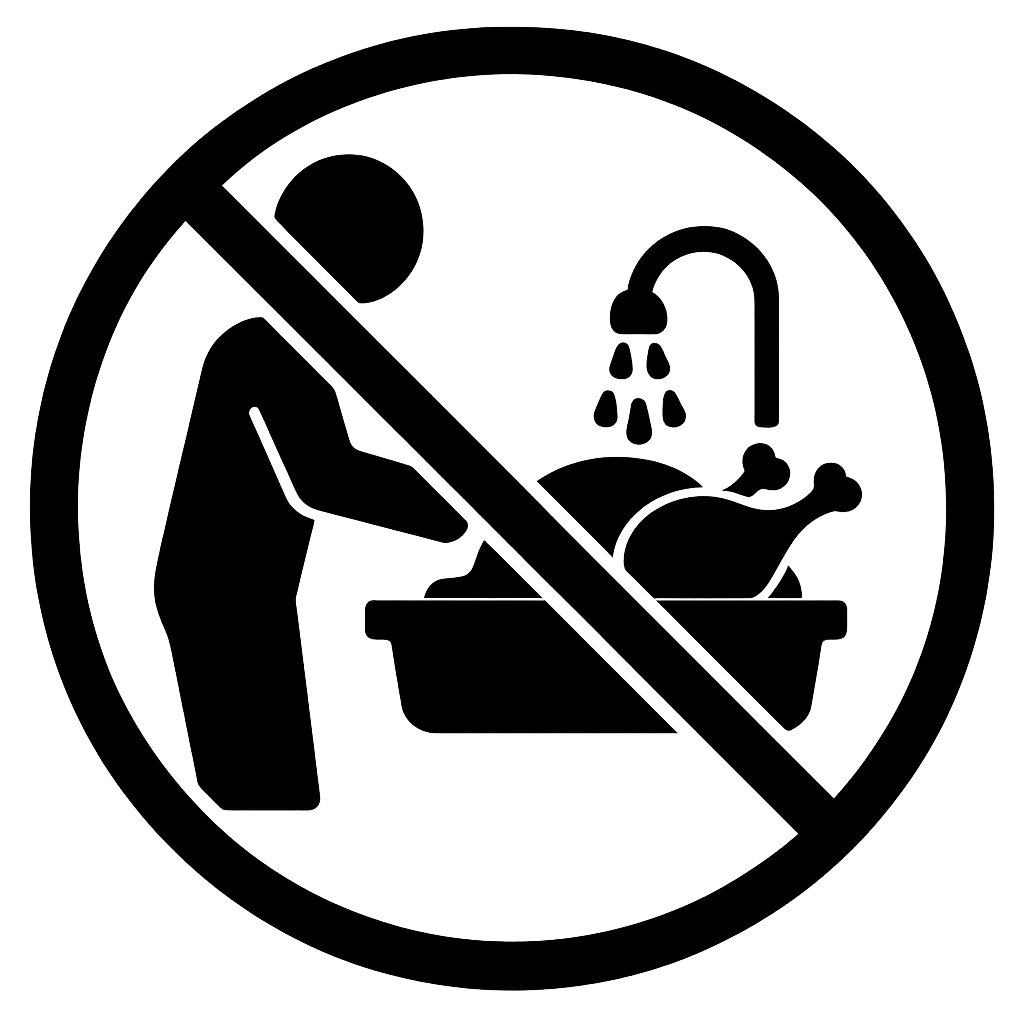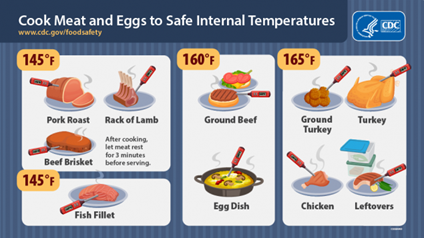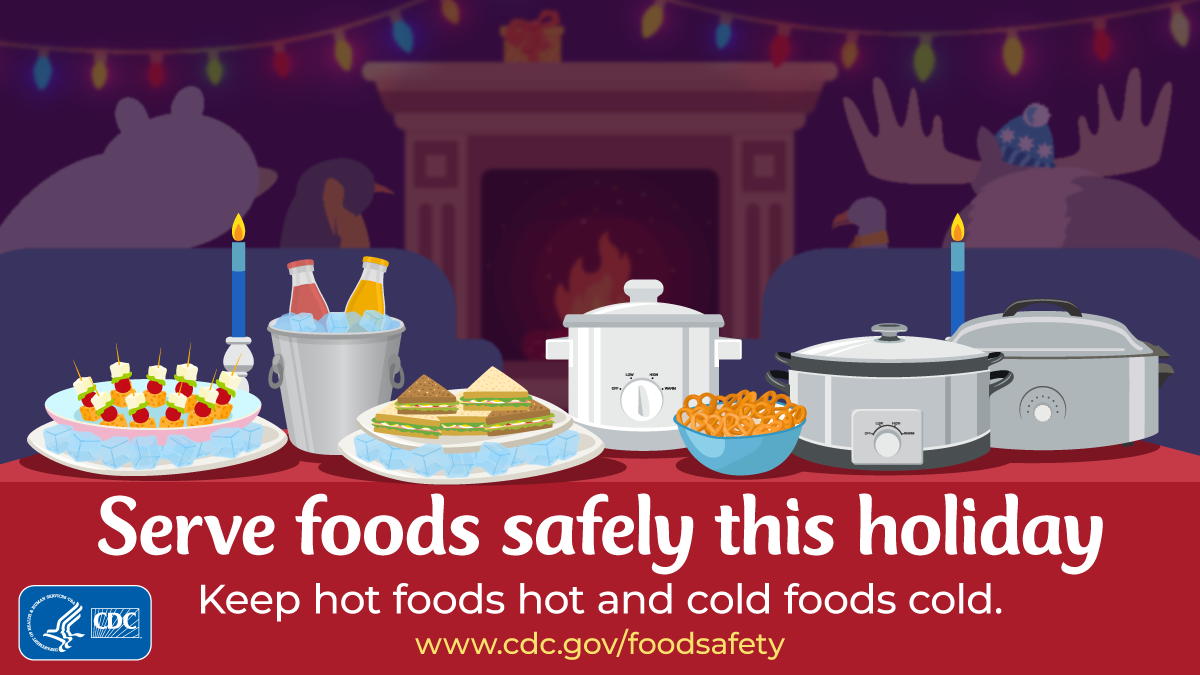Gathering and sharing food with friends and family is a treasured part of holiday celebrations. Environmental Health & Safety offers the following food safety tips to prevent foodborne illness and help ensure that safe meals are an enjoyable part of your holiday.
Remember to use safe food preparation techniques, including:
- Washing hands correctly and at appropriate times;
- Working with clean utensils and surfaces;
- Wiping up spills immediately to avoid cross-contamination; and
- Using a food thermometer to verify meat is cooked to a safe internal temperature.
Follow these steps to help you safely prepare and serve your next holiday meal.
1. CLEAN (AND THAW SAFELY!)
- Wash your hands for at least 20 seconds with soap and hot water before, during, and after preparing food, and before eating.
- Clean kitchen work surfaces and utensils with hot soapy water or in a dishwasher before and after you prepare food.
Choose one of the following options to thaw frozen foods (e.g., raw meats/fish, frozen casseroles) safely:
- In the refrigerator inside a container to prevent any juices from leaking on other foods; or
- Under cold running water or in a leak-proof plastic bag that’s submerged in a sink of cold water (change the water every 30 minutes); or
- In the microwave following the manufacturer’s instructions if it's only a small amount and the food will be cooked immediately.
Never thaw frozen food by leaving it out at room temperature.
At room temperature, the outside of food thaws faster than the center. Germs that cause illness grow rapidly in foods kept between 41- and 135-degrees Fahrenheit (F) - the “temperature danger zone”. Cook or store thawed food in the refrigerator to keep it out of the "temperature danger zone".
2. SEPARATE RAW FROM READY (AND PREPARE FOODS PROMPTLY!)
Keep raw meat, poultry, seafood, and eggs away from cooked or ready-to-eat foods - during storage and preparation.
- Use separate cutting boards and utensils for raw meat; wash these items in hot, soapy water before preparing other foods. Whenever possible, prep fresh produce before raw meat.

- Prepare your turkey safely. Incorrect handling and undercooking poultry often cause foodborne illness. Raw poultry can easily spread to harmful germs to other foods, utensils, and countertops. Do not wash or rinse raw turkey or chicken.
- Complete all food prep within 2 hours, and as a best practice as quickly as possible to minimize time that foods are in "the temperature danger zone".
3. COOK (AND REHEAT) FOODS TO SAFE TEMPERATURES
You can’t tell when a food is “done” cooking by looking at it. Use a food thermometer to verify that food is cooked to safe minimum internal temperatures to kill germs that can cause foodborne illness.
Cook poultry, stuffed foods, and casseroles to at least 165 degrees F. Serve promptly.
Reheat cooked and cooled foods to at least 165 degrees F before serving.

- Turkey: Use a food thermometer to verify that cooked turkey has reached a safe internal temperature of 165 degrees F in the thickest parts of the breast, thigh, and wing joint.
- Stuffing: Cook stuffing separately for safety. If you can’t cook stuffing separately, add it to the turkey just before cooking. Verify that both the turkey meat and the stuffing’s center reach a minimum of 165 degrees F internal temperature. After removing turkey from the oven, wait 20 minutes before taking out the stuffing.
Transport and serve foods at safe temperatures.
- Use chafing dishes, slow cookers, and preheated cambros to keep hot foods hot.
- Use coolers with ice packs and serving dishes in ice to keep cold foods cold.
4. CHILL LEFTOVERS
Plan food quantities wisely to minimize leftovers and prevent food waste.
Keep leftovers safe. Cooked foods like gravies, meats, casseroles, soups and sauces left in the “temperature danger zone” or improperly reheated can grow harmful bacteria. 
Refrigerate or freeze perishable food within 2 hours (1 hour if ambient temperature is above 90 degrees F) or compost it.
- Divide large dishes into shallow, smaller uncovered containers so foods cool quickly to safe cold holding temperatures.
- Freeze or compost refrigerated leftovers that can’t be eaten within 3 to 4 days.
More information
5 Ways to Avoid Getting Food Poisoning
